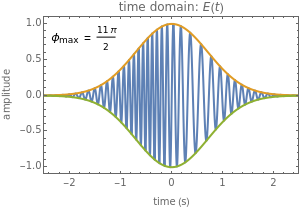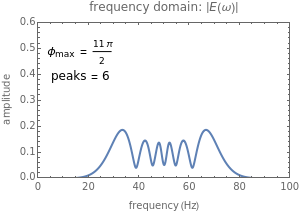Spectral Broadening Induced by Self-Phase Modulation
Spectral Broadening Induced by Self-Phase Modulation
Amplification of ultra-short pulses in optical fibers can be degraded by the nonlinear phenomenon of self-phase modulation (SPM), resulting in considerable spectral broadening and distortion. Variation in the refractive index of the medium is caused by the optical Kerr effect.
This Demonstration simulates the induced spectral broadening caused by SPM. Assume an input pump laser pulse in the time domain is cos(50t), with a Gaussian profile of and a frequency of 50 Hz. After propagation in a photonic crystal fiber (PCF), some new phase components are introduced due to the SPM effect. The new phase is proportional to the intensity of the pump pulse, given by . The pulse resulting from SPM can be represented by cos50t+, where the maximum nonlinear phase shift is a constant, determined by the nonlinearity of the PCF and the pump power. The spectral distribution of this pulse in the frequency domain can be calculated by a numerical Fourier transform. Finally, we can compare this pulse in the time and frequency domains, as shown in the two plots. The relationship between and the number of frequency peaks is =(M-0.5)π.
-
2
t
e
-
2
t
e
-2
2
t
e
-
2
t
e
ϕ
max
-2
2
t
e
ϕ
max
ϕ
max
M
ϕ
max
Details
Details
For more details about self-phase-modulation (SPM) induced spectral broadening, see chapter 4.1 of[1]. The author thanks Jason Biggs for helpful discussions.
References
References
[1] G. P. Agrawal, Nonlinear Fiber Optics, Cambridge: Academic Press, 2012. www.sciencedirect.com/science/book/9780123970237.
Permanent Citation
Permanent Citation
Ruibo Jin
"Spectral Broadening Induced by Self-Phase Modulation"
http://demonstrations.wolfram.com/SpectralBroadeningInducedBySelfPhaseModulation/
Wolfram Demonstrations Project
Published: January 26, 2016

